Tillandsia oropezana
Click thumbnails for full size, scaled to a new window.
Tillandsia oropezana
(See notes below)
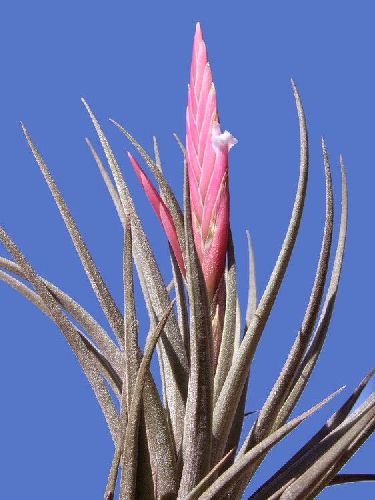
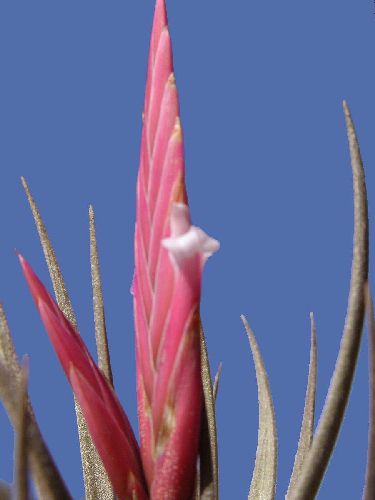
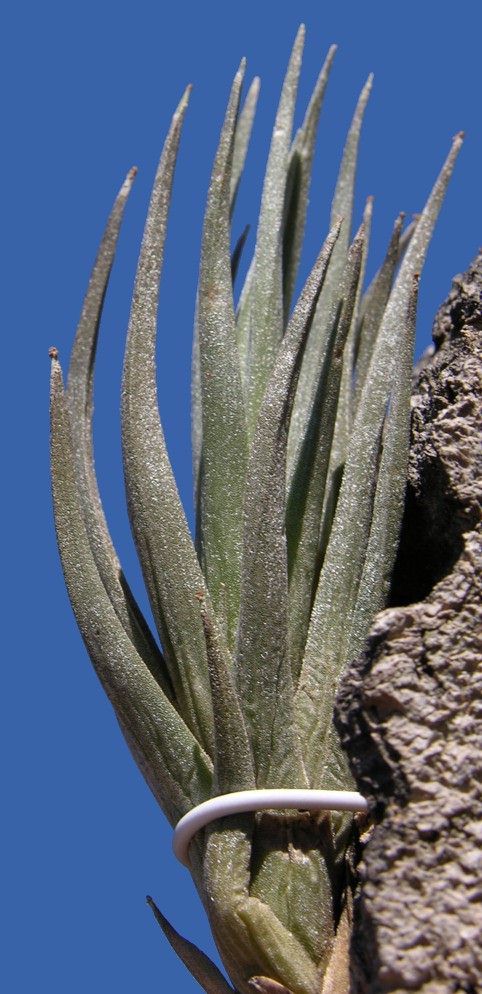

| Len Colgan 04/12. aff. oropezana |
Len Colgan 04/12. "Smaller version" |
Chris Larson 06/14 |
Len Colgan 11/04/12
At long last, I have flowered T. oropezana from Bolivia. The species was discovered and described by Lotte Hromadnik, from whom I obtained this plant.
It has stiff leaves, making it somewhat different to other Bolivian species. My problem is that the description does not tally exactly with my plant, nor does the picture on Derek's CD. As you can see, it has two spikes and the flowers are closer in colour to white rather than pale blue-violet. The bracts are actually a deeper red than the colour displayed by my camera.
Those small flowers are not really Bolivia-esque. This opens up the remote possibility of it being a natural hybrid, but what on earth might be the parents if that was true? T. didisticha?
Chris Larson 11/04/12
Hi Len. The leaves on your plant are totally different to the ones on mine. Mine, from Lotte, look like the photos on the disc – as do the others that I have seen.
The long tubular flowers on T.didisticha are not what I’d consider for likely parentage of your plant – depending on the other parent of course.
Len Colgan 12/04/12
Hi Chris et al. That is interesting. At the time, I purchased two plants from Lotte both with the label T. oropezana. One was a bit larger than the other, but over the years became significantly larger until the current flowering.
The plant currently in flower has leaves that are 14cm long with the inflorescence extending out a bit from the leaves.
I have now attached a picture of the other T. oropezana. It is much smaller, with the longest leaves being only 7cm long. The leaves are a wee bit greener and even stiffer - very stiff, in fact. It has never flowered.
I wonder whether the smaller plant matches yours and also matches the plant on Derek's CD better. If that is the case, then the plant currently in flower might not be a true T. oropezana, which is what Derek has surmised. In that case, what is my plant? As I said, those tiny white (whitish) flowers do look non Bolivia-esque. But the plant must surely come from there as Lotte would never make such a mistake. Interesting, anyway.
Derek Butcher, 12/04/12
Len. You have no option but to call your plant aff. oropezana.
This is what I have on the DVD....
R. Ehlers Feb. 1996
"This plant seems a miracle. We have been two times to the type locality with Lotte. we climbed the rock and looked with binoculars at every stone and outcrop. But nothing. Lotte thought there may be a bigger population somewhere else and her plant only came to the place by coincidence maybe by a bird. But all well but as well there were no parents for a hybrid, no T. argentina, nothing but T. lotteae."
W. Till May 1996....
"Is a very rare plant that makes it suspicious. It was found in 1982 during a trip with other collectors. Only Helmut Hromadnik found a very limited number of specimens. No other plants in vicinity to suggest possible parentage!"
Note that Helmut found the plants in 1982. One must have flowered around 1989 because that was when Lotte described it. No paratypes were mentioned but as Walter says Helmut found a limited number which suggests different plants not all from the same proliferating clump! We must also remember that it is 30 years from the collection date and it is feasible that self set seed was propagated by Lotte
Chris Larson 27/06/14 ... "I hate to think how many I imported, or rather ordered, before this one got through – most times I ordered it, it was not available. Such a beautiful little plant, only 1 to 1 ½” tall. It seems even o/s it is rare. 1800m in Bolivia – found in 1 small colony in 1 location. Possibly a T. argentina hybrid."

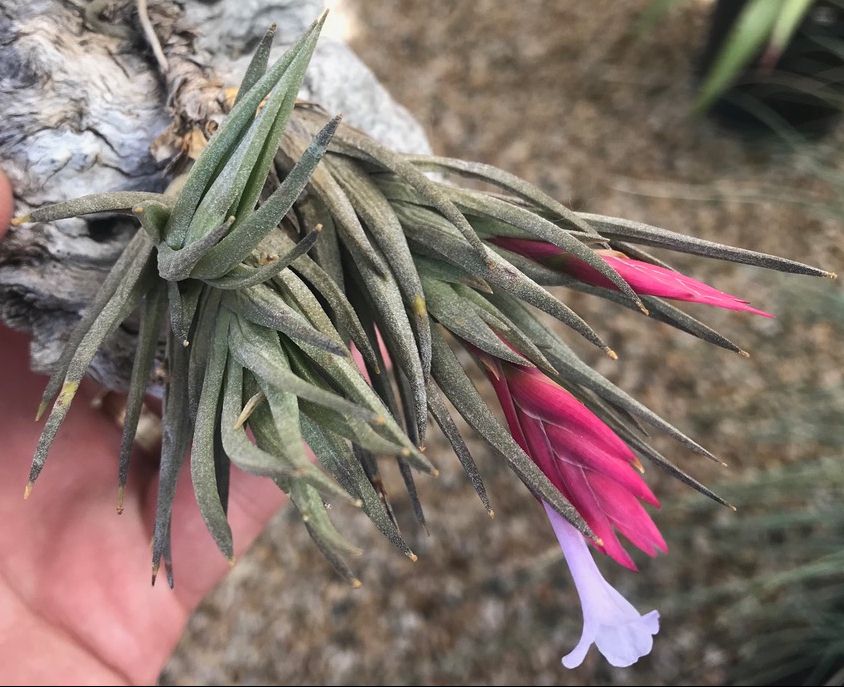
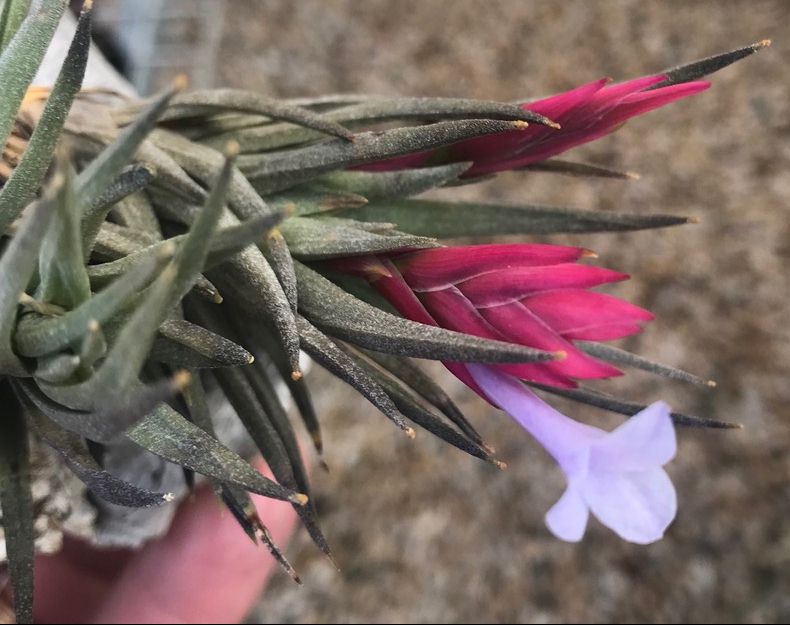
| Len Colgan 11/14. The smaller, true one. |
Ray Clark 10/18 |
Len Colgan 2/11/14 ... "Several years ago, I purchased two plants from Lotte Hromadnik, both labelled T. oropezana. They looked a bit different.
One of them flowered two years ago, (see BinA images at top of page). Immediately, Peter Tristram and others replied that it definitely was not T. oropezana.
The other (smaller) one is now in flower, and this one is correctly named. (see above: Len Colgan 11/14)
But the mystery still remains as to what the other one is. I am guessing it also comes from Bolivia, but does not exactly match any of the species I have seen from that country. Mind you, it does look vaguely like T. bermejoensis and T. boliviensis, except for the foliage. Luckily, I have young offsets on it. Does anyone have a suggestion ?"
Ray Clark 31/10/18 ... "I’ve been watching and waiting and today here it is. T. oropezana flower spike has opened and bloomed. The plant is ex UD, ex Lotte and although growing well is threatening to fall of its mount and I haven’t had the heart to tamper with it, maybe when the flowers have finished."
Peter Tristram 31/10/18 ... "Good job blooming it! Here the very few I have are plumping up endlessly but never blooming. One day! At least they can take the heat and humidity of recent summers. I don’t expect we’ll be able to import species like this very often, if ever."
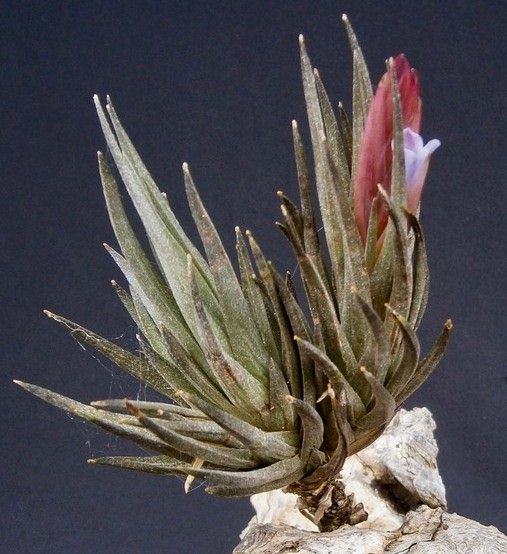
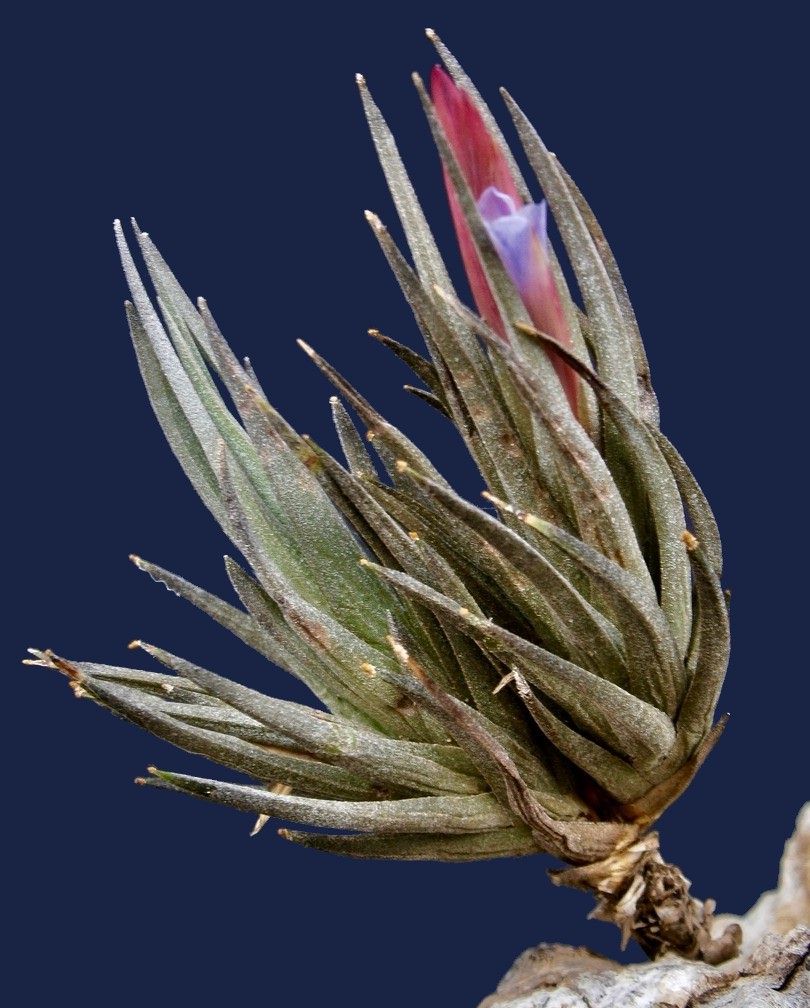
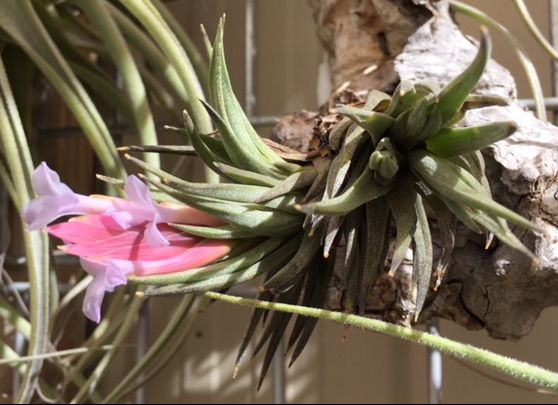

| Ray Clark 08/17 |
Ray Clark 04/18 |
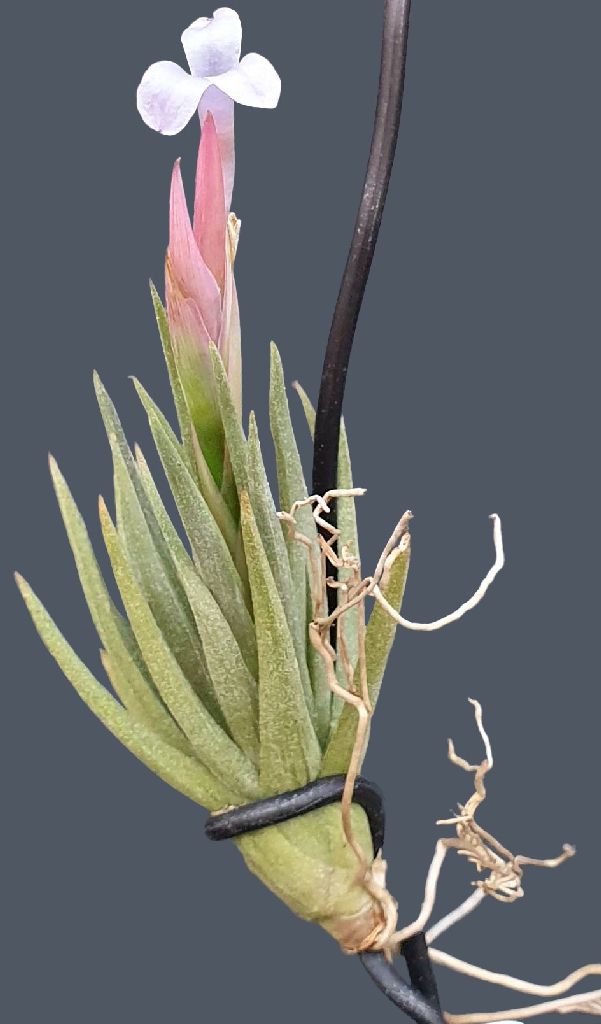
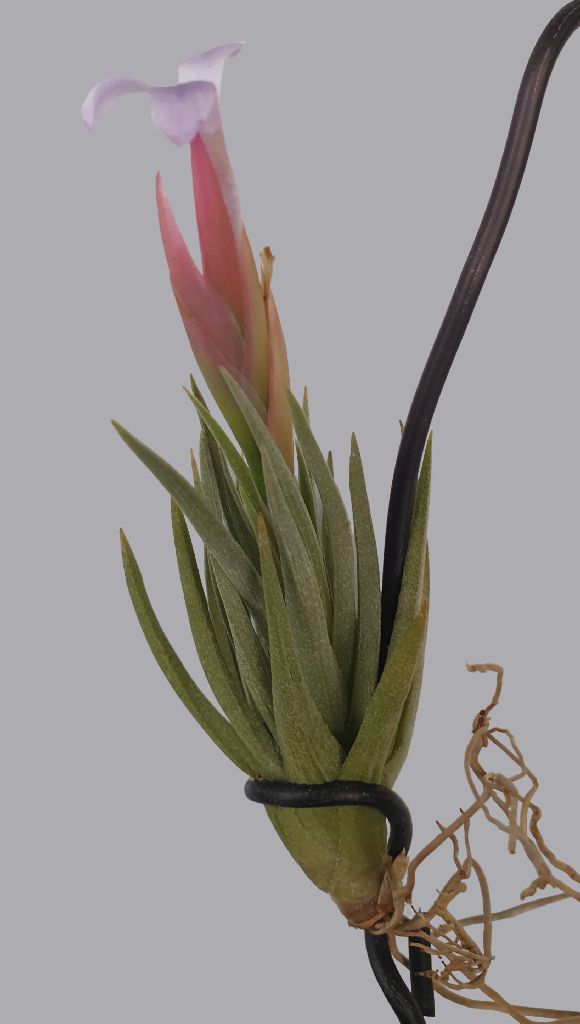
Tillandsia oropezana L Hromadnik Die Bromelie 1/ 1989 p14-17
A T.argentina C. H. Wright, cui affinis, habitu caulescente, foliis stricte erecto-curvatis non canaliculatis, spica multiflora intemodis brevibus, bracteis florigeris majoribus rhachidem celantibus percarinatis, sepalis aequaliter breviter connatis, petalis pallide coeruleo-violaceis obtusis et rotundatis parte superiore non revolutis sed solum patentibus differt.
Holotypus: H. Hromadnik 9012, Bolivia, Depto. Chuquisaca, Prov. Oropeza, cursus superiorfluminis Rio Chico prope pagum Chaco, 1800 m. s.m., 8. 7. 1982 (WU).
Translsted from the German by Butcher
PLANT- Short stemmed, polystichous leaved, thin rosette, flowering to 14cm high, afew spreading, growing on rocks in small groups.
LEAF - Stiff, straight & erect, partly secund, towards bent above, to 6cm long, making a thin open rosette.
LEAF SHEATH - Triangular, ca 15mm long, indistinct from the blade, at the bottom 15mm wide and covering the stem, inside 6mm high, naked, bare, shiny, light greenish, in dry state almost white, thick leathery, on the other hand the sides are thin and transparent, outside 8mm high, naked.
LEAF BLADE - Thin triangular, dark grey green, 4-5cm long, at the base 5-6mm wide, in cross section outside half round, tip keeled, inner becoming smooth, grooved.
LEAF TIP - Triangular, awl-like, smooth above with dense joined together sessile scales with a circle of very short (flugelzellen) ? = winged cells.
SCAPE - ca 3cm long, masked by the stem bracts, thin, naked.
SCAPE BRACT - Densely adjacent, thin membranous, transparent, naked, nerved, the lower ones violet-red blotched, 22mm long with a more subfoliate, awl-like and lepidote tip. The upper, similar to the flower bracts 25-30mm long to 7mm wide, oval lance like, short tipped, reddish.
INFLORESCENCE- Simple, overhanging the leaves, strongly complanate, distichous spike, oval lance like 40mm long, 14mm wide, ca 8 flowered, rhachis strongly bent, edged, 2.5mm thick, 1mm wide, naked green. Internodes 3-4mm long.
FLOWER- Densely distichous, sessile, thin tubular, the upper part open wide, not scented, self fertile.
FLOWER BRACT - Densely adjacent and covering the rachis, the tips sticking out, sepals widely exceeding, to 30mm long, 8mm wide, oval lance-like, tipped, thin, naked, nerved, with wide transparent wavy edge, sharply keeled, cherry red.
SEPAL - Uniform, almost free, greenish, naked, nerved, lancelike tip, 16mm long, 4mm wide, the back keeled, keel pink.
PETAL - Light blue violet, to 35mm long, the bottom section 2-3mm wide and forming a thin tube, platte to 7mm wide, rounded, opening wide and reflexed, the upper edge in the middle crenate and half jutting out.
STYLE & STIGMA - Enclosed in flower tube, but is visible in the open throat of the corolla, 23mm long. Filament - white, ribbon like, upper half a pleated bundle. Pollen beige. Anther- 4mm long, 0.5mm dia. joined at the base, beige. Stigma - white, with thin spreading wide lobes of type I(B&G 1984) Style - filiform, white.
OVARY - greenish white, oval, 3mm long, 2mm dia.
HABITAT - Bolivia, Dept. Chuquisaca, Prov. Oropeza, Upper reaches of Rio Chico, near the village of Chaco, 1800 M.
It differs from T. argentina in
1.- A caulescent habit
2.- Upright curved leaves, not channelled
3.- Flower stem with shorter internodes
4.- Floral bracts larger, carinate, and cover the rhachis
5.- Sepals equally short connate
6.- Petals pale blue violet, obtuse and rounded above not revolute but spreading out.
Notes:
R. Ehlers Feb. 1996
This plant seems a miracle. We have been two times to the type locality with Lotte. We climbed the rock and looked with binoculars at every stone and outcrop. But nothing. Lotte thought there may be a bigger population somewhere else and her plant only came to the place by coincidence maybe by a bird. But as well there were no parents for a hybrid, no T. argentina, nothing but T. lotteae.
W. Till May 1996
Is a very rare plant that makes it suspicious. It was found in 1982 during a trip with other collectors. Only Helmut Hromadnik found a very limited number of specimens. No other plants in vicinity to suggest possible parentage!
Updated 17/08/20












